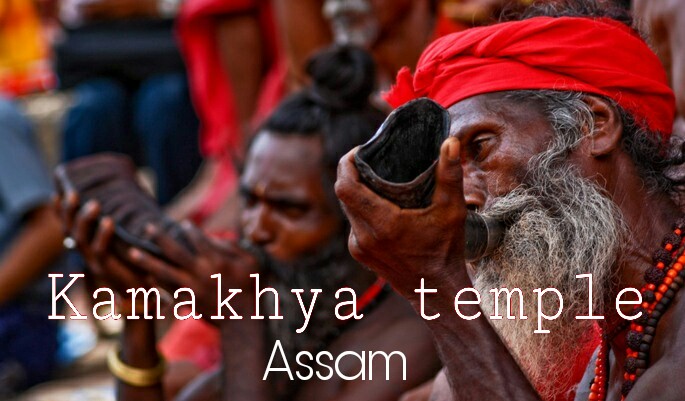Modern Hinduism has changed a lot from its earlier form. Many practices once common was considered taboo now. However we can still find temples following those methods of worship in some parts of the country. Kamakhya temple in Assam is one among them. Midst the utmost secrecy of these rituals, the temple is quite popular and visited by thousands every day.
Kamakhya is a temple in the township in Guwahati, Assam. Situated on the banks of river Brahmaputra, on a small hillock shrouded in mysteries called Nilachal.
The mythical history of Kamakhya;
Once Daksha, Sathi’s father organized a “yagna”, wherein Shiva was not invited. Despite Shiva’s disapproval, she decided to go forth to attend the “yagna”. But she was not accepted inside, feeling insulted she committed suicide in the sacrificial fire. Furious Shiva cut off Daksha’s head and devastated the “yagna”. He soon found to be in great distress without his counterpart. Seeing this agony God Vishnu with his chakra cut down the dead body of Sathi from Shiva to bring him back to the realization of absolute.
Belief is that the pieces of Sathi’s body fell in different places, each place became a “Shakti Pith” and later a place of worship. Kamakhya is an important place of worship among all the “Shakthi Pitha“. It is believed that the genitals or “yoni” of Sathi fell here.

Apart from Kamakhya Devi, 10 other avatars of Kali namely Dhumavati, Matangi, Bagola, Tara, Kamala, Bhairavi, Chinnamasta, Bhuvaneshwari and Tripuara Sundari are worshiped here in the temple complex. Unlike other temples, we cannot see any idols inside but the sculpture of yoni or vagina of the goddess is the object of worship.
Although little is known about the history of the temple, first epigraphs appear from the 9th century CE Tezpur plates of Vanamalavarmadeva wherein a massive temple structure is being recorded. In the early days, Kamakhya became a center for tantric sacrifices, mysticism, sorcery and have contributed significantly to early Tibetan Buddhism.
When I had decided to visit Kamakhya, my guru told not to go at any time during Ambubachi Mela, held in the first week of June. Ambubachi Mela is the largest annual festival where lakhs of Aghoris, Nagas and Bhariavis come here when their divine mother is menstruating. It is believed that the yoni bleeds with red waters during the period of Ambubachi. The temple remains closed until the waters of the yoni become clear again.
I chose few weeks after Ambubachi just to make sure that crowd is less and to visit all the places peacefully. Guwahati is well connected by air and rail with other parts of the country. Hotels are comparatively cheaper in Kamakhya. I stayed in a hotel run by one of the pujaris (priest) of Kamakhya. There are few restaurants but make sure to finish dinner by 7.30 pm, as the town sleeps by 8.00 pm.
When the temple is open, there always is a heavy crowd, hence a visit to the temple can take hours. There are three “yoni” inside the main temple dedicated to goddesses Lalitha, Kamala and Mathangi. The main “yoni” which is very large and protected with a silver fence is seen covered with red cloths. It is always filled with flowing warm water with a very strong pubic pungent odour.
I got a quick access to visit the temple because of my pujari friend at the hotel. Later came out and sat on the rocky steps on one side of the temple for meditation. The other side of the temple is a deep stretch down leading to other yoni temples.
There are total 12 “yonis” in the entire hillock. Two being male and 10 being female. The “yoni pith” of Vishnu is just outside the main temple and is regarded as the most sacred. To the immediate left is a small temple for Thara with a beautiful stone carving of “Ugra Thara” breast feeding Shiva. Walking further down on left side leads to the “Dakshina Kalika Yoni” temple.

It was a no moon day night, people gathered at the temple with liquor bottles and were worshipping their goddess. The atmosphere was serene and was slightly breezy. I sat on the rock steps for hours and completely forget about time. It was the temple security who woke me up, asked to leave so that he can close the main gates. Time was past 12 in the night.
The next day I went to visit for other temples in the complex. A small walk uphill will take you through “Bagalamukhi” leading to the “Bhuvaneswari” temple whose yoni was dry and waterless. The priest told if water ever appears in the yoni, it will lead to a deluge. A breath taking the view of Brahmaputra River can be seen from there. From there we can spot the small island in the middle of Brahmaputra, with a temple in the name of “Umanand”.
Decided to visit the island, for that I had to catch a ferry. The Brahmaputra is not serene as Ganges, it is wide and deep and shows its fury at times. Ferry crossing was a pleasure but expensive. Freshwater dolphins were jumping out of the water. I reached the island, the temple was small, well maintained but less crowded. The ferry at the island is a good choice to take a dip in the river, but one should be very careful as the Brahmaputra is one of the most unpredictable rivers.




